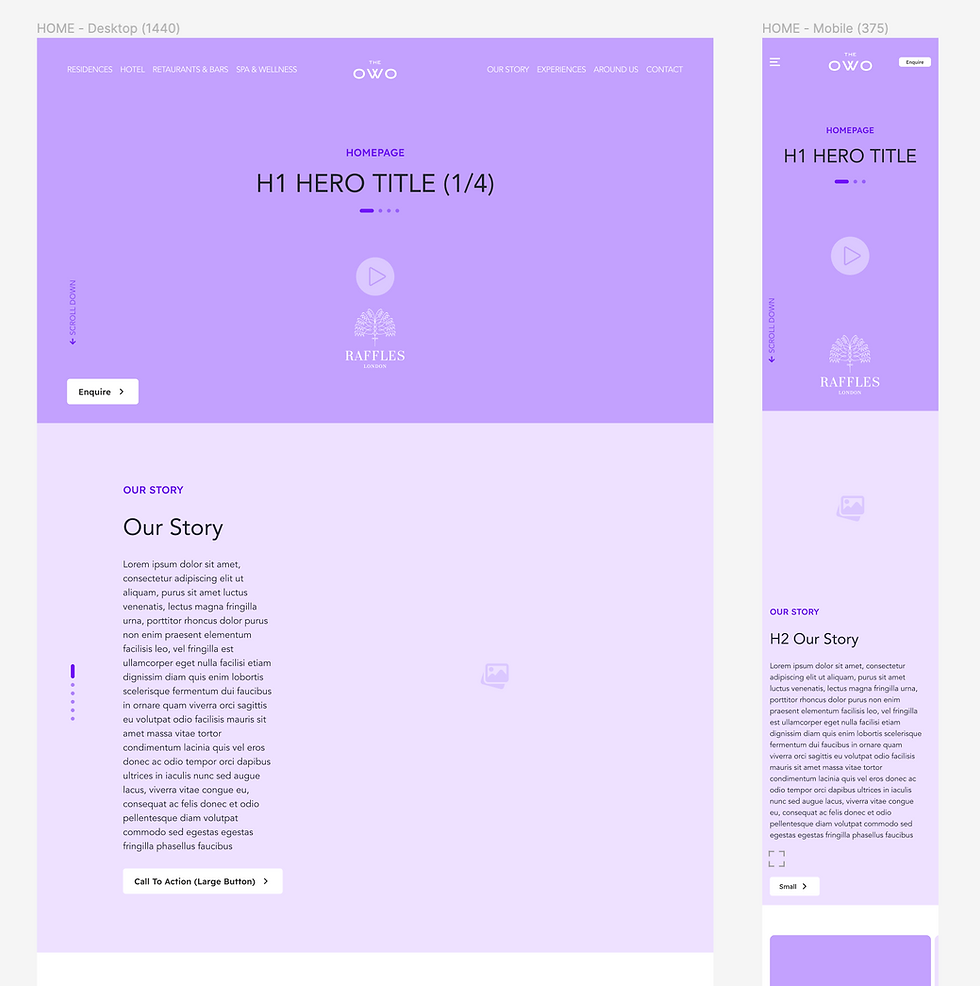A Journey of Luxury: Retrospective on the Raffles Hotels TheOWO.London Website Redesign
- Liam Charlton
- Jan 21, 2023
- 3 min read
Embarking on a website redesign project for a prestigious brand like Raffles Hotels is an opportunity to create a digital experience that matches the grandeur and elegance of their physical establishments. In this retrospective, we explore the successes and learnings from the TheOWO.London website redesign project. Join us as we dive into the intricacies of designing for the top 1% of earners and uncover the key insights that drove the project's success.

Successes that Set the Stage
TheOWO.London website redesign project boasted several standout successes. One notable achievement was the excellent direction and insight into the target audience, who typically represent the top 1% of wealth in the world. This deep understanding of the user allowed the team to craft an experience tailored to their discerning tastes and expectations.
Another success was the establishment of art direction from the project's inception. Although wireframes are typically created before art direction, this unconventional approach proved highly effective. By retroactively creating wireframes based on the established direction, the team streamlined the pipeline from UX to UI, accelerating the design process significantly.
Furthermore, the decision to build a component library from the beginning proved instrumental in speeding up page development and maintaining a consistent visual identity throughout the site. This not only reduced the development load but also contributed to a seamless and cohesive user experience.

Lessons Learned: Understanding the Raffles Hotels User Psychology
Designing for Raffles Hotels users proved to be a unique challenge that required a deep understanding of their distinctive psychology. These users place great importance on visual elements, necessitating careful consideration during the UX stage to create ample space for captivating photography and videos to shine.
Additionally, this particular user segment perceives the world differently from most other people. To optimize engagement and conversion, the team strategically placed call-to-action elements where users were most likely to be highly engaged. By developing specific copy that aligned with their mindset, the site's messaging effectively guided users down the conversion funnel.
Tools and Techniques that Drove Success
In the TheOWO.London website redesign project, the team employed a range of tools and techniques to achieve remarkable results. Figma emerged as the go-to tool for prototyping, fostering collaborative design processes and enabling seamless iteration.
Excel played a crucial role in tracking detailed project direction notes and monitoring progress. By maintaining a comprehensive record, the team ensured clear communication and alignment with stakeholders throughout the project.

Areas for Improvement: Copywriting and Time Management
The retrospective shed light on areas that could benefit from improvement. Copywriting, which commenced later in the project, presented a challenge. To address this, the team needed a deep understanding of the target user to craft UX copy that could later be refined by a copywriter.
Furthermore, the lack of initial photography posed a hurdle in the design process. Extensive research was required to identify visual stimuli that would resonate with the target audience, allowing the team to develop components that could seamlessly accommodate photography later.
Moving Forward: Enhancing Efficiency and Clarity
To optimize future projects, the retrospective identified several areas where adjustments are recommended. The project's large scale, with over 40 pages, required intense efforts to meet deadlines and standards. Improved time management and more realistic estimations will be crucial in ensuring a smoother project timeline without compromising quality.
Another suggestion for improvement is to streamline design tools. Using both Figma and XD added unnecessary time spent converting files between platforms. Unifying the design tools would eliminate this additional step and enhance overall efficiency.
Additionally, clarity in communication was identified as an area for improvement. Feedback from Raffles Hotels sometimes reached the team secondhand via the project director. Recording meetings and reviewing them in context could provide firsthand feedback, fostering clearer communication and reducing the risk of misinterpreted messages.

Conclusion
The Raffles Hotels / TheOWO.London website redesign project stands as a testament to the power of a well-executed UX design process. By understanding the unique psychology of Raffles Hotels users and leveraging tools like Figma and Excel, the team successfully transformed the digital experience for this esteemed brand. While challenges were overcome, stakeholders, agencies, and users were ultimately satisfied, marking the project as a resounding success. The retrospective serves as a guide for future endeavours, emphasising the importance of user psychology, efficient time management, and clear communication in creating exceptional digital experiences for luxury brands.


